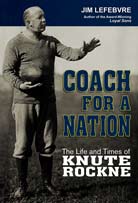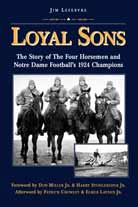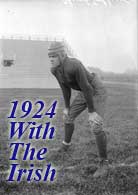Edgar “Rip” Miller was a standout student and football player at Notre Dame in the early 1920s, when he was asked by teammate Russ Arndt to come along on a short trip to nearby Elkhart, Indiana. Arndt was dating Miss Phyllis Templin, who said she had a younger sister who wanted to meet a Notre Dame man.
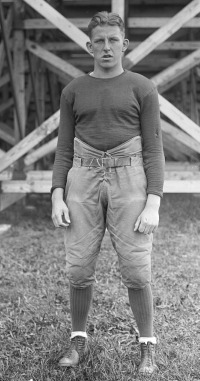 |
| Rip Miller, ND right tackle, 1924. |
Rip grudgingly agreed, but devised a means of signaling Arndt during their double date. “If I don’t like the girl, I’m holding up one finger, and I’m out of here,” Miller said. “Two fingers means I’ll stick around.”
Stick around he did. About five years later, in 1928, Rip Miller and Esther Templin were married. Phyllis ended up marrying Miller’s teammate along the Irish line, Noble Kizer.
Rip Miller and Noble Kizer were among 11 Notre Dame seniors comprising the first team for the Irish in 1924.
In the third game of the season, their backfield of quarterback Harry Stuhldreher, halfbacks Don Miller and Jim Crowley, and fullback Elmer Layden were dubbed “The Four Horsemen” by sportswriting legend Grantland Rice. Their subsequent publicity photo, coupled with the team’s success, cemented their fame.
Across the nation, sports fans read of the precision, speed and teamwork of “the horsemen” and Knute Rockne’s “wonder team” at Notre Dame. Later in the season, during a road trip, a knock came on the door of the room occupied by Adam Walsh, ND’s center and captain.
“Is this where ‘the four horsemen’ are staying?” came the question.
“Nah,” shrugged Walsh. “I guess we’re just the ‘seven mules.’”
Together, the two units formed an unstoppable squad. The Irish turned back the best teams from every section of the country – Eastern powers Army and Princeton on back-to-back road trips; Western Conference elites Wisconsin and Northwestern; the South’s banner carrier Georgia Tech; the best from the Plains, Nebraska; and the Pacific coast champion Stanford, in the Jan. 1, 1925 Rose Bowl.
The result – a 10-0 record and Notre Dame’s first consensus national championship. Along the way, the Irish literally took the game of college football from coast to coast, becoming the first team to play games in New York City, Chicago and southern California in the same season. The phenomenon of Notre Dame football swept the nation, as thousands were drawn to this dynamic team.
Rip Miller, like all his senior teammates from 1924, went into college coaching in 1925. In a couple of years, he was coaching at the U.S. Naval Academy. He took over as Navy head coach in 1931, and over the next six years led the Middies to their first three victories over Notre Dame.
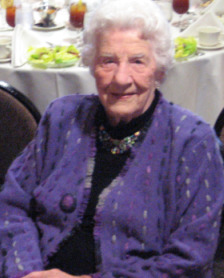 |
|
Mrs. Esther Miller, celebrating her 102nd birthday on Nov. 14, 2008.
|
The Millers never left Annapolis, raising their three children while Rip went on to become Navy’s assistant athletic director. In total , he served the Academy for nearly a half-century before retiring in 1974. He was inducted into the College Football Hall of Fame in 1966, and died in 1991 – the last of the 1924 ND regulars to pass.
But his widow Esther, who was five years his junior, survives to this day!
She is healthy, vibrant and full of memories of the “good old days” when Rip played and coached football.
Esther turns 103 on Saturday, Nov. 14, a week after the annual renewal of the Notre Dame vs. Navy series. She still attends most Navy home games.
Last year, the day before the game in Baltimore, Mrs. Miller was honored by a capacity crowd of 350-plus at the joint ND-Navy luncheon…. on her 102nd birthday. At that time, plans were announced for a future trophy for the ND-Navy rivalry to be dedicated to Rip Miller.
The complete story of Rip Miller’s (and his teammates’) days with the Fighting Irish is told in the award-winning book, Loyal Sons: The Story of The Four Horsemen and Notre Dame Football’s 1924 Champions. The book has been honored with two national awards for excellence.
For more on Loyal Sons, click here.
Happy Birthday, Mrs. Miller!

